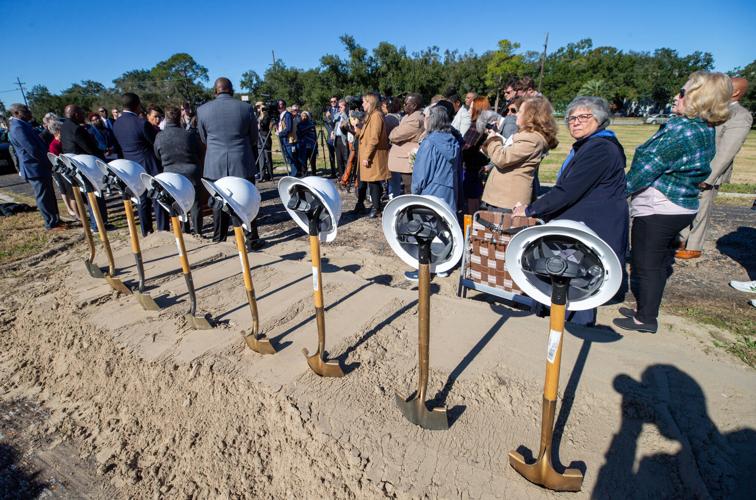Mayor LaToya Cantrell’s administration has fumbled a $141 million grant for green infrastructure projects, according to a report from a federal watchdog, with poor planning, misallocation of funds and a lack of workers undercutting the city's efforts to keep stormwater at bay.
In one case, a grant-funded program to add porous pavement and other upgrades to New Orleans homes — which the city has previously touted as a success — was so poorly handled that it actually made some properties more vulnerable to flooding, according to an audit released this week by the Department of Housing and Urban Development’s Office of Inspector General.
The audit, conducted over nine months ending in July 2023, said construction had not started on any of the eight grant-funded infrastructure projects comprising the “Gentilly Resilience District,” which is supposed to hold stormwater in redesigned green spaces that would otherwise flow directly to the often-overwhelmed city drainage system.

New Orleans Mayor, LaToya Cantrell talks during a ground breaking ceremony on the Mirabeau Water Garden, a signature "green infrastructure" project on the grounds of a former convent on Mirabeau Ave. in New Orleans, Monday, Dec. 11, 2023. (Staff photo by David Grunfeld, The Times-Picayune | NOLA.com)
New Orleans was forced to cancel two of the projects because it hadn’t secured agreements with landowners and utility providers, the audit said. And though the city has since told HUD it is reviving those two projects, — one focused on stormwater reduction in Milneburg and another for a microgrid to provide backup electricity — the auditors said the city hasn’t supported that claim with documentation. Auditors said HUD should work with the city to find a better use for the $14.4 million dedicated to those projects.
“With more than seven years having passed and the city’s history of insufficient planning, no staffing plan, insufficient staffing and depleting planning and administration funds, we are concerned that the city will not be able to complete these projects,” the auditors said.
Long delays
The audit comes as Cantrell and other city officials have faced withering criticism in recent years for the pace of progress on federally funded projects, many of which were left to her administration to complete by former Mayor Mitch Landrieu. City residents have long complained about torn up streets that are part of a $2 billion FEMA funded roads program, though the pace of construction has picked up in recent months. Cantrell was also unable to gain traction on a plan to use $38 million in FEMA funds to turn the Municipal Auditorium into a new city hall.

New Orleans Mayor, LaToya Cantrell talks during a ground breaking ceremony in New Orleans, Monday, Dec. 11, 2023. (Staff photo by David Grunfeld, The Times-Picayune)
The green infrastructure grant was awarded to New Orleans in early 2017, towards the end of Landrieu's second term. It was the second largest of 13 grants in HUD’s $1 billion National Disaster Resilience competition for cities and states.
The grant was celebrated as validation of the city's efforts to find new ways to adapt to increasingly strong rain storms resulting from climate change, and Cantrell has trumpeted the Gentilly Resilience District projects at conferences around the world.
But the city had spent just 15% of its award by September 2023, earning HUD’s designation as a “slow spender.” The grant-funded stormwater projects, which are designed to hold 50 million gallons of water, were supposed to be completed by the initial spending deadline of 2022.
Timelines have been repeatedly pushed back as the city encountered numerous obstacles, including archaeological requirements, redesigns and lack of coordination among contractors.
City officials have also blamed a series of disasters, starting with the 2019 cyberattack, the pandemic and two hurricanes. But the HUD OIG said the city was already showing slow progress by the time of the cyberattack.

New Orleans Mayor, LaToya Cantrell talks during a ground breaking ceremony on the Mirabeau Water Garden, a signature "green infrastructure" project on the grounds of a former convent on Mirabeau Ave. in New Orleans, Monday, Dec. 11, 2023. (Staff photo by David Grunfeld, The Times-Picayune | NOLA.com)
In December, officials insisted that a number of green infrastructure groundbreakings were just around the corner, with $269 million in construction on 22 projects — including those in the Gentilly Resilience District — expected to begin this year.
The city did recently break ground on the Mirabeau Water Garden, a long-delayed green infrastructure project on a 25-acre empty lot near Bayou St. John. The first phase of that project now under construction is receiving some funding from the Federal Emergency Management Agency, but the city must come up with 51% of the $30 million cost. FEMA typically requires a 25% local share.
The second phase of the Mirabeau project, which focuses on recreational components, is slated for funding from the HUD grant.
A smaller FEMA-funded green stormwater project in the Oak Park neighborhood was completed in December.
The status of the city's other projects isn't clear. A Cantrell spokesperson did not immediately respond to a request for comment.
Problems with spending
New Orleans wasn’t the only HUD grant recipient to have trouble getting money out the door, and HUD twice agreed to push back the spending deadline for all grantees, extending it from 2022 to 2029.
But the OIG found serious problems even with the little money the city has spent thus far.
A disproportionate share of grant funding thus far — $10 million — has gone to planning and administration, and nearly half the budget for those activities is now depleted, auditors found.
That leaves open the possibility that the city will run out of budgeted grant funds and be forced to pay out of pocket to see all the projects through.
In its responses to the audit, the Cantrell administration said it is working on improvements to how it conducts risk assessment, monitoring and cost allocations, as well as its staffing plan.
Making things worse?
The only grant-funded initiative to be completed thus far is for a program to encourage homeowners to replace concrete slabs with more absorbent structures, and to install rain barrels, planters and trees. But HUD found major problems with that $6 million project, overseen by the New Orleans Redevelopment Authority, a state agency.
NORA oversaw 184 property modifications and HUD inspectors found problems in all 50 of the retrofitted properties they examined.
Gravel had washed away, weeds had sprung up and new pavers to replace the slabs didn’t properly absorb water. In one instance, a contractor removed a water drainage system around another house, resulting in ground floor flooding during a storm.
Two-thirds of the 41 program participants that auditors interviewed said they were concerned about some aspect of the work; four participants said the retrofits had made flooding worse.
The program placed “financial and physical burdens on program participants, some of whom were elderly and had medical conditions,” auditors said.
NORA's own survey data tell a different story, with 98% of participants reporting that they are satisfied with the program, according to letter from NORA Executive Director Brenda Breaux to the Cantrell administration.
Breaux said NORA had hired a licensed engineer to review conditions on the properties in the audit, finding that there were no significant impacts to how well the modifications worked.
In an email, Breaux said the audit findings are misleading because they rely "on a small number of perceived challenges reported by individual participants, as well as superficial observations and generalizations that reflect limited understanding" of the program.
She noted that program participants chose their own modifications, which require ongoing maintenance, adding that many of the issues identified in the audit are cosmetic.




